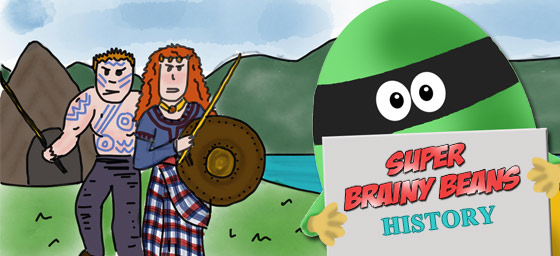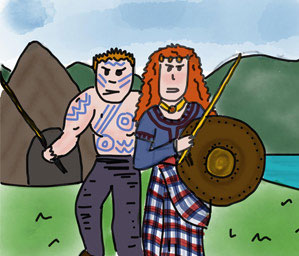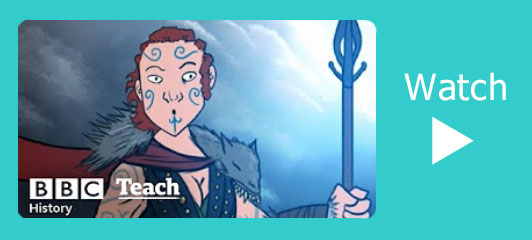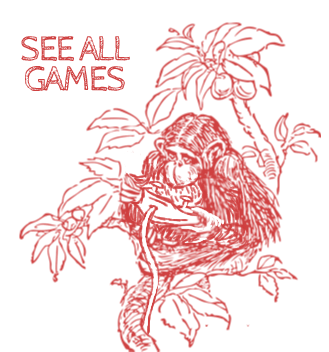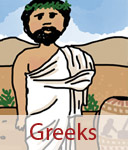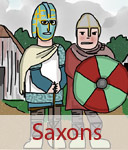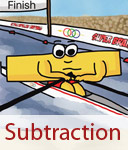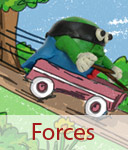The Celts KS2
The Celts KS2 for kids learning at Primary School. Homework help on the history of Celts, the Iron Age facts, Celtic life and Boudicca.
Time: 800BC - 43AD
Who were the Celts?

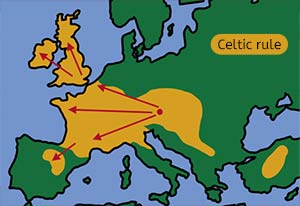 The Celts were a group of people who lived during the Iron Age, a time that began around 800 BC and lasted until the Roman invasion of Britain. They were not one single tribe with one ruler, but a collection of many different tribes that shared similar customs, languages, and beliefs.
The Celts were a group of people who lived during the Iron Age, a time that began around 800 BC and lasted until the Roman invasion of Britain. They were not one single tribe with one ruler, but a collection of many different tribes that shared similar customs, languages, and beliefs.
The Celts first lived in Central Europe and, over time, spread across the continent. By the time the Romans arrived, Celtic tribes could be found in Britain, Ireland, France (where they were called the Gauls), and even parts of Spain. Each tribe had its own leaders and warriors, but they were all linked by common traditions.
Despite being spread out, the Celts had a lot in common. They loved storytelling, passing down myths and legends about gods, heroes, and magical creatures. They were also famous for their skilled craftsmanship, making weapons, jewellery, and tools from metal. Above all, they had a strong connection to nature—they believed rivers, trees, and even certain animals were sacred.
The Iron Age
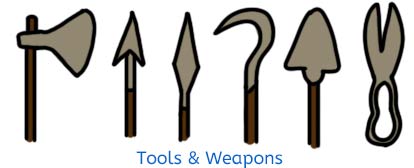 The Iron Age was a very important time in history. Before this, people made their tools and weapons out of bronze (a mixture of copper and tin). Bronze was useful, but it wasn’t as strong as iron and could bend or break quite easily. When people discovered how to make things out of iron, everything began to change!
The Iron Age was a very important time in history. Before this, people made their tools and weapons out of bronze (a mixture of copper and tin). Bronze was useful, but it wasn’t as strong as iron and could bend or break quite easily. When people discovered how to make things out of iron, everything began to change!
Iron was much tougher and sharper than bronze. This meant that farmers could use strong iron ploughs to dig into hard soil, which made growing crops much easier. Villages could produce more food, and this helped them to grow in size. Iron axes and saws also made it quicker to chop down trees and build homes or forts.
For the Celts, the Iron Age was a time of great progress and invention. With new iron weapons such as swords, spears, and shields, Celtic warriors became more powerful in battle. This not only helped them defend their villages but also allowed them to fight against rival tribes.
The Iron Age also meant people could create new types of jewellery and tools, showing off their skills in metalwork. Iron changed everyday life—from farming to fighting—and helped the Celts thrive for many hundreds of years.
 BBC - Iron Age
BBC - Iron AgeA fun interactive site with stories and games. View their fact file and Celtic crafts.
 Castell Henllys
Castell HenllysStep back in time at Castell Henllys, a unique Iron Age hill fort re-created with fantastic replica Iron Age roundhouses, dating back 2,400 years.
What was Celtic life like?
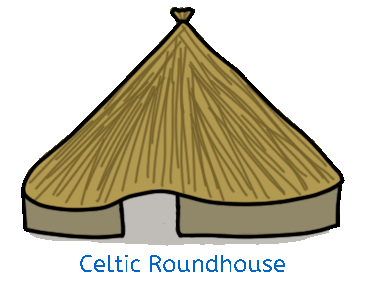 Life in a Celtic village was busy, noisy, and full of activity. Everyone had a role to play, from farming and cooking to making tools and keeping the animals safe. Let’s take a closer look at how the Celts lived:
Life in a Celtic village was busy, noisy, and full of activity. Everyone had a role to play, from farming and cooking to making tools and keeping the animals safe. Let’s take a closer look at how the Celts lived:
Homes
The Celts lived in roundhouses—circular homes made from wood or stone, with cone-shaped roofs covered in thatch (dried grass or straw). Inside was just one big room where the whole family cooked, ate, worked, and slept together. A fire burned in the centre, giving light, warmth, and a place to cook food. Smoke drifted out through a hole in the roof. Around the roundhouse, villages were often protected by hillforts—strong walls or ditches built on hills to keep enemies away.
Farming and food
The Celts were excellent farmers. They grew crops like wheat, barley, and oats, which they used to make bread, porridge, and even ale. They raised cows, sheep, goats, and pigs for milk, wool, leather, and meat. Hunting deer and wild boar added variety to their meals, and they also fished in rivers and the sea. At feasts, the Celts enjoyed roasted meat, fresh vegetables, cheese, and sometimes honey as a sweet treat. Food was shared, and feasting was an important part of Celtic life.
Arts and crafts
The Celts were very skilled craftworkers and loved to make things both useful and beautiful. They were especially good at metalwork, creating swords, shields, tools, and stunning jewellery. Rich Celts wore torcs (thick metal necklaces), brooches, and bracelets, often made from gold or bronze. They decorated their work with spirals, knots, and animal shapes, patterns which are still famous today as “Celtic designs.” Even everyday items like pots, bowls, or weapons were decorated with swirls and patterns—art was part of everything they did.
Religion
The Celts had a deep connection to nature and believed that the world around them was filled with gods and spirits. Rivers, trees, mountains, and even certain animals were thought to be sacred. To please these gods, the Celts made offerings, sometimes throwing precious objects like jewellery or weapons into lakes and rivers as gifts to the spirits. Religious leaders called Druids were very important—they led ceremonies, gave advice to rulers, and passed on stories, traditions, and laws by word of mouth.
- Archaeologists have discovered real Celtic offerings at the bottom of rivers and lakes in Britain—so the Celts’ gifts to the gods are still there thousands of years later.
- The Celts were excellent traders and travelled long distances to exchange goods. They traded items like salt, animal skins, and jewellery with other tribes and even with the Romans before they became enemies.
 10 Awesome Facts
10 Awesome Facts10 facts you didn't know about Celtic life. From their good roads, their weird helmets to their passion for fighting and their riches.
The Celts and the Romans
When the Romans invaded Britain in AD 43, the Celts were already living here in tribes. At first, many Celtic tribes fought fiercely against the Roman soldiers, but over time the Romans took control of more and more land. Some tribes made peace with the Romans, while others continued to resist.
The Romans built towns, roads, and forts, which were very different from Celtic roundhouses and hillforts. They also brought new ways of farming, new foods, and even new gods. Slowly, many Celts began to live more like Romans, though some of their traditions, art, and beliefs continued for hundreds of years.
- Roman soldiers were amazed by the Celts’ courage and wild battle cries. Some even wrote that Celtic warriors were among the fiercest fighters they had ever faced.
- Unlike the Romans, the Celts didn’t have one big empire or a central ruler. Each tribe had its own leader, and they often fought with other tribes over land and resources.
Celtic Warriors
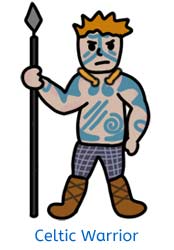 The Celts were famous for being fierce and fearless fighters. Battles were a regular part of their lives, as different tribes often fought one another over land, animals, or resources. They also had to defend themselves when invaders like the Romans arrived. To the Celts, being a warrior was a sign of honour, and bravery in battle was one of the most important qualities a person could have.
The Celts were famous for being fierce and fearless fighters. Battles were a regular part of their lives, as different tribes often fought one another over land, animals, or resources. They also had to defend themselves when invaders like the Romans arrived. To the Celts, being a warrior was a sign of honour, and bravery in battle was one of the most important qualities a person could have.
Body Paint
Before going into battle, Celtic warriors painted their bodies with striking blue patterns made from a plant dye called woad. The swirling designs weren’t just decoration—they were meant to make the warriors look terrifying and almost otherworldly to their enemies. Imagine facing a group of shouting warriors with blue-painted bodies charging towards you—it would have been very frightening!
Hairstyles
Celtic warriors also styled their hair in dramatic ways before battle. They used a chalky substance, like lime, to stiffen and spike it up. This made their hair stand tall and wild, adding to their fearsome appearance. Combined with their body paint, the warriors must have looked quite extraordinary.
Weapons and Shields
Celtic warriors fought with iron swords, spears, and daggers. They also carried large, decorated shields, often painted with bold patterns or symbols that may have shown their tribe. Some warriors fought from chariots pulled by horses, which allowed them to move quickly across the battlefield and strike suddenly. Chariots were also a symbol of wealth and power, so only the most important warriors used them.
Celebrations
After a victory, the Celts loved to celebrate with great feasts. These gatherings were full of roasted meat, bread, and drink, with music and dancing to lift spirits. Bards, who were poet-musicians, played an important role at these feasts. They sang songs and told epic stories about the bravery of warriors and the heroes of the tribe, making sure their deeds were remembered for generations.
Who was Boudica?
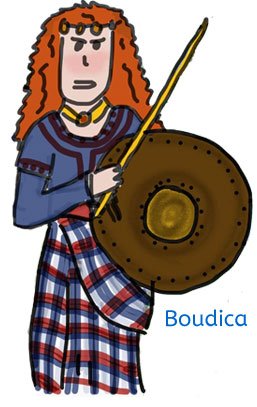 One of the most famous Celts in history was Boudica, the fearless queen of the Iceni tribe in Britain. Her story is one of courage, strength, and determination in the face of the powerful Roman Empire.
One of the most famous Celts in history was Boudica, the fearless queen of the Iceni tribe in Britain. Her story is one of courage, strength, and determination in the face of the powerful Roman Empire.
Boudica’s husband, King Prasutagus, ruled the Iceni tribe peacefully while the Romans controlled much of Britain. But when he died, the Romans broke their promises. They tried to take over all the Iceni lands and demanded heavy taxes. To humiliate the tribe, the Romans tied Boudica to a post and beat her in front of her people, and even mistreated her daughters.
This cruelty made Boudica furious, and she swore revenge. Gathering her tribe, she raised a huge army of Celts, men and women alike, all determined to fight back. First, they attacked the Roman town of Colchester, burning it to the ground. Then they marched on London and St Albans, destroying both cities. The Romans were shocked at how powerful and successful her army had become.
For a short time, it looked like Boudica might drive the Romans out of Britain completely. But when she finally faced the main Roman army, things changed. The Romans were better trained and more disciplined. Despite Boudica’s bravery and the size of her force, the Romans won a crushing victory.
Rather than be captured and paraded as a prisoner, Boudica chose to take her own life by drinking poison. She became a legend, remembered as a queen who stood up for her people’s freedom against one of the greatest empires in history.
 Boudicca's attack
Boudicca's attackThis is Boudicca. She lived a very long time ago. She fought against the Romans when they came to take her land.
 Colchester
ColchesterRegular guided tours of Colchester run throughout the year, charting the town's journey from Camulodunum - the Roman capital destroyed by Boudica - to present-day Colchester.
 Boudica statue - London
Boudica statue - LondonA famous statue of Boudica riding a chariot with her daughters stands in London near the Houses of Parliament, so her story is still honoured today.
What happened to the Celts?
Over time, the Roman Empire grew stronger and more powerful, and eventually the Romans conquered most of the land where the Celts lived. In Britain, the Romans built stone towns, straight roads, forts, and walls like Hadrian’s Wall, leaving behind many things that can still be seen today. Life in Roman Britain became very different from the old Celtic ways.
But the Celtic way of life did not completely disappear. In fact, the Celts continued to live alongside the Romans, keeping many of their own customs, especially in the countryside. When the Roman Empire finally collapsed hundreds of years later, Celtic traditions remained strong in certain places.
In Ireland, Scotland, and Wales, where the Romans never fully conquered, Celtic culture carried on. These areas held onto their own languages, music, myths and legends inspired by the Celts. Many Celtic stories about heroes, magical creatures, and gods were passed down through the generations.
Even today, we can still see the influence of the Celts in Britain and Ireland. Celtic artwork and knot patterns, traditional festivals, and even some of the languages—like Welsh, Irish Gaelic, and Scottish Gaelic—are living links to the ancient Celts.

